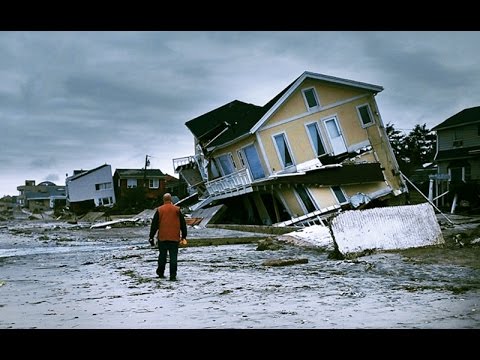Doubling times of 10, 20 or 40 years yield sea level rise of several meters
Paleoclimate data reveal that subsurface ocean warming causes ice shelf melt and ice sheet discharge.
According to a new study, sea level rise of several meters might happen faster then previously thought.
Based on data from past climate changes, when sea level rose to +5–9 m, including the occurrence of extreme storms – during a time when temperatures were less than 1 ◦C warmer than today, experts warn of similar consequences in coming decades. Also because the rate of current emissions today happens faster.
The main culprit seems to be ice sheets which become in contact with warmer ocean waters. Thus, become vulnerable to non-linear disintegration, which means a rapid succession of land based ice sheets flushing into the ocean.
The study abstract explains
We argue that ice sheets in contact with the ocean are vulnerable to non-linear disintegration in response to ocean warming, and we posit that ice sheet mass loss can be approximated by a doubling time up to sea level rise of at least several meters.
Doubling times of 10, 20 or 40 years yield sea level rise of several meters in 50, 100 or 200 years. Paleoclimate data reveal that subsurface ocean warming causes ice shelf melt and ice sheet discharge.
Our climate model exposes amplifying feedbacks in the Southern Ocean that slow Antarctic bottom water formation and increase ocean temperature near ice shelf grounding lines, while cooling the surface ocean and increasing sea ice cover and water column stability.
Ocean surface cooling, in the North Atlantic as well as the Southern Ocean, increases tropospheric horizontal temperature gradients, eddy kinetic energy and baroclinicity, which drive more powerful storms.
We conclude that 2 ◦C global warming above the preindustrial level, which would spur more ice shelf melt, is highly dangerous. Earth’s energy imbalance, which must be eliminated to stabilize climate, provides a crucial metric.
Many people live near the ocean or large parts of food production happen in river deltas. With sea level rise of several meters in a few decades, it becomes questionable how or if people can learn to adapt. Obviously large populations are forced to move when storm surges and salt water intrusion render existing habitats uninhabitable.
Source
Ice melt, sea level rise and superstorms: evidence from paleoclimate data, climate modeling, and modern observations that 2 ◦C global warming is highly dangerous
Authors: J. Hansen, M. Sato, P. Hearty, R. Ruedy, M. Kelley, V. Masson-Delmotte, G. Russell, G. Tselioudis, J. Cao, E. Rignot, I. Velicogna, E. Kandiano, K. von Schuckmann, P. Kharecha, A. N. Legrande , M. Bauer, and K.-W. Lo
PDF: http://www.atmos-chem-phys-discuss.net/15/20059/2015/acpd-15-20059-2015.pdf
See also
Eric Rignot: Observations suggest that ice sheets and glaciers can change faster, sooner and in a stronger way than anticipated http://climatestate.com/2015/06/09/eric-rignot-observations-suggest-that-ice-sheets-and-glaciers-can-change-faster-sooner-and-in-a-stronger-way-than-anticipated/
Sea-level rise due to polar ice-sheet mass loss during past warm periods http://www.sciencemag.org/content/349/6244/aaa4019.short
